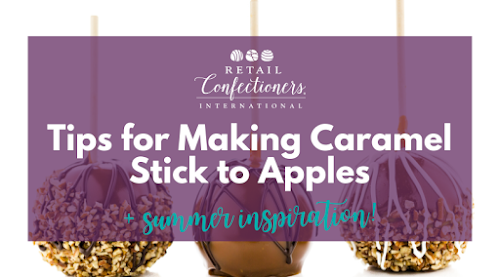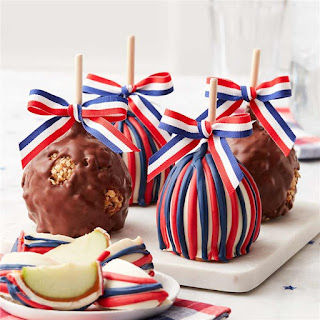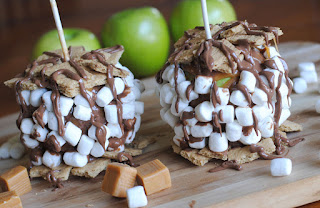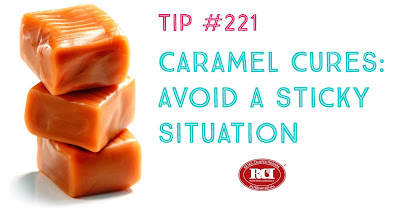|
|
Posted By RCI,
Tuesday, June 30, 2020
Updated: Thursday, July 30, 2020
|
Have you ever experienced problems with caramel slipping off your caramel apples? The wax on your apple may be the culprit. By simply wiping each apple with a damp cloth prior to dipping, you can remove the waxy residue that rests on the apples. An apple naturally produces a waxy film to protect itself, however, in some instances additional food-grade wax is added by suppliers to further increase an apple’s shelf life. For this reason, it could save you time and effort to request unwaxed apples from your supplier, if they do add wax to their apples. If that doesn’t help, consider adding white compound to your caramel at a 5 to 1 ratio to help it better adhere to the apple. If you can’t wait to test this out, here’s a few summer-inspired caramel apples ideas to try too! Patriotic Caramel Apples
Show your patriotic stripes with drizzles of red and blue over a white chocolate coated caramel apple. 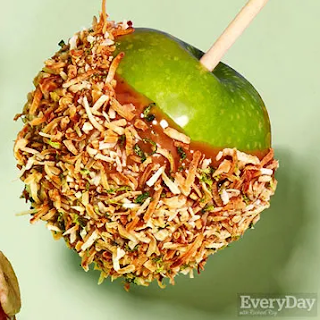
Zesty Coconut Caramel Apples
Think tropical by adding a generous helping of toasted coconut and a little lime zest to your caramel apples. 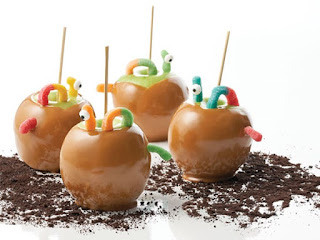
Wormy Caramel Apple
Turn shoppers heads with these fun, wormy caramel apples! S’mores Caramel Apples
Transform your caramel apples into a s’mores lover’s dream by adding layers of graham crackers, marshmallows and drizzled chocolate. Was this tip helpful? If so, let us know in the comments below. Crave more? If you like what you read here, look for the "Subscribe now" box on the right to enter your email address and start receiving weekly tips, like this, delivered straight to your email inbox. RCI's Tip of the Week blog is just one of the many resources we offer to help candy makers refine their craft and build upon their business and marketing practices. Not a member? Click here to learn how RCI can help you build your sweet business.
Tags:
4th of July
Apple
Candy Hacks
Caramel
Caramel Apple
Caramel Apples
Caramels
Coconut
Idea Sharing
Inspiration
Problem Candy
S'mores
Something on a Stick Day
Summer
Permalink
| Comments (0)
|
|
|
Posted By RCI,
Tuesday, November 26, 2019
Updated: Monday, April 27, 2020
|
How Instagram-worthy are your holiday treats?
Sure, they taste delicious, but how would a potential new customer know if they’ve never tasted your confections? No surprise, social media, like Instagram and Facebook, can be an effective tool for reaching consumers, however if A.) you’re not sharing photos of your products on your social media sites daily or B.) they don’t stand out from other holiday gifts, you could be missing out on a massive opportunity to gain new customers this season.
A study by Forbes has shown that 78% of consumers’ purchases are impacted by companies’ social media posts. So, if you’re looking for a boost in sales, consider transforming these classic confectionery treats into holiday showstoppers to help your business standout this season.
Rice Cereal Treats
Cookie cutters aren't just for cookies. They also make a great tool for creating fun seasonal chocolate-covered rice cereal treats. Make the most out of your collection of cookie cutters, by repurposing common shapes to create new and unique designs. After realizing that their gingerbread man treats weren’t selling as well as other designs, Bomboy’s Home Made Candy gave the tired cookie cutter new life by turning it upside down and transforming it into Rudolph the Red-Nosed Reindeer. This little reindeer proved to be a hit!
Make fall and summer designs last into the holidays! If you have cookie cutters shaped like a ghost or even an ice cream cone, just flip them upside down to transform the shapes into cute elves. Did you know a pumpkin cookie cutter can be repurposed to make a jolly Mrs. Claus?
Caramel Apples
Traditionally a fall treat, a little creativity can help transform caramel apples into a festive holiday gift. For inspiration, mimic Santa’s jolly belly by adding his signature black belt and big gold buckle around a red caramel apple coated in red sprinkles or luster dust. Bring Frosty the Snowman to life by adding a jumbo marshmallow to the top of a caramel apple before dipping them both in white chocolate. A few chocolate chip “buttons" and a red licorice scarf will help tie it all together. Lastly, add candy eyes, a red nose and antlers, of course, to create everyone’s favorite reindeer out of a classic chocolate-covered caramel apple. There’s lots of ideas online for creating Rudolph’s antlers—from the easiest to the most realistic, you may want to try pipe cleaners, pretzel twists or sugar cookies for your antlers.
Marshmallows
Jumbo marshmallows make a quick and easy canvas for creating holiday magic. Put three jumbo marshmallows on a stick, coat them in white chocolate and decorate to make marshmallow snowmen pops that are too sweet to pass up. Click here to watch a tutorial by Two Sisters Crafting. All you need to make adorable gingerbread marshmallow pops are, your choice of caramel-coated marshmallows or marshmallows covered in peanut butter confectioner’s coating, some piped white chocolate and tiny sugar decorations.
Sandwich Cookies
If you don’t think of Rudolph the Red-Nosed Reindeer when looking at your favorite sandwich cookies, changing your perspective may increase your holiday sales. When RCI member Vande Walle’s Candies coated Nutter Butter sandwich cookies in chocolate and embellished them with a pair of candy eyes, pretzel twist antlers and a bright red nose, these cute reindeer treats reportedly “flew out the door,” they were so popular with their customers! For another spin on this idea, try substituting the Nutter Butter cookies with Oreo cookies on a stick.
More than ever, consumers are looking to social media for unique and memorable gift ideas this holiday season. Posting photos of your festive holiday treats on social media regularly will help your company capture the attention of consumers while they’re making their shopping list this season.
Crave more? If you like what you read here, look for the "Subscribe now" box on the right to enter your email address and start receiving weekly tips, like this, delivered straight to your email inbox. RCI's Tip of the Week blog is just one of the many resources we offer to help candy makers refine their craft and build upon their business and marketing practices.
Tags:
Caramel
Caramel Apples
Christmas
Creativity
Elf
Gingerbread
Holidays
Marketing
Marshmallow
Member Ideas
Nutter Butter
Oreo
Reindeer
Rice Cereal Treats
Santa
Snowman
Social Media
Permalink
| Comments (0)
|
|
|
Posted By RCI,
Tuesday, August 20, 2019
Updated: Monday, April 27, 2020
|
Rumor has it Starbucks will officially begin serving up their coveted Pumpkin Spice Lattes earlier than ever—August 27, if you’re curious. That’s only a week away! If you choose to go by the “more official” calendar date to mark the first day of fall, you’ve got until September 23 [insert sigh of relief here].
Regardless of when you choose to acknowledge the true arrival of fall, it won’t be long before it’s time to say “goodbye” to cool and refreshing flavors like watermelon and citrus, and “hello” to warm and cozy fall flavors like, well, pumpkin spice. Thanks to Starbucks, you can expect to find pumpkin spice in everything from coffees to cookies, candles to skin care, and, yes, even deodorant. Click here to check out some of RCI’s favorite pumpkin spice ideas.
Even if you draw the line at trading in your favorite deodorant for the seasonal variety, there’s something comforting about fall flavors, but you don’t have to limit yourself to pumpkin. Keep reading for a list of equally craveable flavors to fall in love with this fall.
APPLES
Pumpkin may reign king of fall, but one might say the apple is queen. This certainly isn’t a surprise if you already make caramel apples, but you may consider different ways to incorporate the unofficial fruit of fall, by mimicking the flavors in apple cider or warm apple pie.
RCI member, Hilliard’s Chocolates, evokes all the fall feels with their Apple Pecan Caramel Bark. Presented at a past Candy Clinic, the bark combines white chocolate, cinnamon oil, dried apples, caramel and cinnamon sugar for a welcome fall treat. RCI members: Login at retailconfectioners.org/candyclinic to view past presentations like this one.
BROWN BUTTER
Take your rich and buttery confections to the next level with brown butter, which is essentially a magical transformation that happens moments before it becomes burnt butter—naturally Martha Stewart has a solution for fixing burnt butter, click here for video. The nutty and complex flavor of brown butter will elevate any recipe. Check out this recipe for Browned Butter Salted Caramel Sauce by TheChunkyChef.com.
CHAI TEA
Quite possibly a distant relative to the pumpkin spice latte, chai tea is a strong-flavored tea with a hint of sweetness. Ginger and pepper add a kick of spice, which is evened out with earthy notes from cardamom and cloves, plus a dash of cinnamon. Why not try this Food Network recipe for Chai Chocolate Truffles, which Giada De Laurentiis compares to a “giant warm hug.”
DARK BEER
Beer is a great addition to any caramel and brittle recipe, but if you’re already incorporating beer into your confections try experimenting with the darker beers of the season. Take note of seasonal beer varieties like porter and stout, which will soon replace the lighter ales of summer.
RCI member, Joy Lyn’s Candies partners with a local brewery to create a peanut brittle made with Sierra Nevada’s Pale Ale. Coined as “Beer Brittle,” this popular confection is made in small batches and offers a subtle hint of hops and malt.
PEARS
If your customers love your caramel apples, get ready to knock their wooly socks off this fall with caramel-dipped pears. Experts agree pears that are not quite ripe with long stems for dipping are best--the most popular varieties being Bosc, Anjou, Comice and Seckel pears. Unlike apples, most pears (Seckel being an exception) don’t take well to having sticks inserted into them, which is why a sturdy stem is important. Check out this recipe for Caramel Dipped Pears from TheKitchenMcCabe.com.
It’s undeniable, the pumpkin spice trend isn’t going anywhere…at least until Starbucks launches their holiday-themed drink menu (enter: Peppermint Mocha), but that doesn’t mean there aren’t plenty of other great fall flavors to peak shoppers’ interest. We want to know, what’s your favorite fall confection? Please share in the comments below.
Crave more? If you like what you read here, look for the "Subscribe now" box on the right to enter your email address and start receiving weekly tips, like this, delivered straight to your email inbox. RCI's Tip of the Week blog is just one of the many resources we offer to help candy makers refine their craft and build upon their business and marketing practices.
Tags:
Apple
Bark
Beer
Brittle
Brown Butter
Caramel
Chai
Fall
Flavors
Pear
Truffles
Permalink
| Comments (0)
|
|
|
Posted By RCI,
Tuesday, August 6, 2019
Updated: Monday, April 27, 2020
|
Caramels are one of the most popular candies, usually characterized by a smooth, chewy texture. In an excerpt for RCI’s Kettle Talk magazine, Randy Hofberger of R&D Candy Consultants shares how to avoid common problems like grainy texture or hardening that can develop as caramel ages.
1. CORN SYRUP SOLIDS>SUCROSE SOLIDS
When formulating your caramel recipe, the most common rule of thumb is to use more corn syrup solids than sucrose solids. This should be on a solids basis, for example, you need at least 1.25 pounds of corn syrup in your formula for every pound of sugar (sucrose).
2. DISSOLVE SUGARS
All of the sugars have to be dissolved before the completion of the cooking cycle or they will become nuclei or "seed" for graining to start. To have all of the sugar crystals dissolved, there has to be sufficient moisture in the formula—at least 20% moisture in your caramel premix to properly dissolve sugar crystals. One of the best ways to ensure a fully dissolved caramel premix is to heat it to 160˚F–180˚F while agitating and before starting the cooking process.
3. ADD SCRAP AT THE RIGHT TIME
If reworking scrap caramel, it is best to add it to the premix at the beginning of the cook cycle with sufficient moisture (remember the 20% moisture premix rule). If you have fresh scrap that is free of grain, this can be added at any time of the cooking process.
4. ADD MILK BEFORE COOK CYCLE IS COMPLETE
Different caramels procedures and recipes may require you to add milk during the cooking cycle. Make sure all of the milk is added before the end of the cooking process. Adding milk after the cook cycle may not allow the lactose in the milk to dissolve and this will promote caramel graining.
5. WASH SIDES OF KETTLE
If you have a gas-fired cooking kettle, you will want to wash down the sides of the kettle after a full rolling boil has been established. This is essential to, once again, dissolve any sugar crystals that may be on the sides on the kettle. Also make sure that the boiling level of the caramel is above the scrapers or sugar crystallization will occur.
6. AVOID EXCESSIVE AGITATION
After the cooking procedure is finished, stop the agitators in the cook kettle. Continuous agitation or excessive handling of the caramel will cause it to grain.
7. MANAGE MOISTURE
Hardened caramels are a common texture concern, which can happen when the product loses moisture. Ways to manage moisture and maintain shelf life include; adding humectants, coating the caramel in chocolate and using good, sealed barrier packaging.
8. COLDER STORAGE
As a general rule, lowering storage temperature by 18º F will double shelf life of caramel.
9. USE CHOCOLATE AS A MOISTURE BARRIER
Caramel hardening and moisture migration can occur when a drier inclusion comes in contact with a higher moisture caramel. Adding crisped rice or pretzels to the caramel will eventually cause these inclusions to get soggy and the caramel to become hard. A simple solution, if your operation permits, is to put the dry inclusion, such as crisped rice, in the chocolate that enrobes the caramel center. Chocolate acts as a moisture barrier to keep the crisped rice crunchy and the caramel soft. Putting a chocolate or specialty fat layer between caramel and a cookie base will, likewise, help keep the two components with their original texture.
Great caramels require great effort. With these tips, you can ensure your caramels stay great and your efforts aren't wasted.
Crave more? If you like what you read here, look for the "Subscribe now" box on the right to enter your email address and start receiving weekly tips, like this, delivered straight to your email inbox. RCI's Tip of the Week blog is just one of the many resources we offer to help candy makers refine their craft and build upon their business and marketing practices.
Tags:
Caramel
Formulations
Grain
Hardening
Production
Shelf Life
Permalink
| Comments (0)
|
|
|
Posted By RCI,
Tuesday, April 3, 2018
Updated: Monday, April 27, 2020
|
We’ve all heard the saying “don’t cry over spilled milk,” the same could be said for burnt caramel. Mistakes in the kitchen happen and sometimes there’s nothing you can do but put the mistake behind you and move on. Before pitching the botched batch, here are a couple ideas for salvaging your burnt caramel.
 |
| Masahiro Makino / Getty Images |
One option would be to try masking the bitterness of burnt caramel by incorporating instant coffee into the mix. There is something comforting about this flavor combination, plus with an extra jolt of caffeine, the only tears shed over this concoction will be tears of joy. Try this recipe for cozy coffee caramels from TheSpruce.com.
If you're feeling adventurous, embrace the burnt flavor and use it as a opportunity to get creative. According to FoodIngredientsFirst.com, burnt caramel is one of the hot new flavor trends for 2018, “A burnt caramel flavor pairs the sweet, milky notes of the caramel with the deep and slightly smoky characteristics of burning the caramel.”
With National Caramel Day on April 5, you might just have to burn a batch of caramel “on accident” to celebrate! Share in the comments below if you have other solutions for fixing burnt caramel.
Tags:
Burnt Caramel
Caramel
Trends
Permalink
| Comments (0)
|
|
|
Posted By RCI,
Tuesday, November 14, 2017
Updated: Monday, April 27, 2020
|
This week’s tip helps you manage your time and maintain the quality of your candies, which is especially important with the busy holiday season ahead.
Set your candy thermometer with an alarm for one or two degrees lower than your cooking time to ensure you don't overcook.
When you start a batch of caramel and walk away to work on packaging, you’ll be alerted to the candy cooking process with enough time to remove it or begin the next step before it gets even one degree too high.
Programmable candy thermometers like the one pictured on the left are available on Amazon starting at $21.99.
Looking for other supplies? From thermometers to taffy. Chocolate to caramels. Moulds to mixers and peanuts to packaging solutions, RCI's Buyer's Guide is your all-in-one resource for products and services needed to run your business. Remember, RCI members can login to access RCI Buyer’s Guide on the member side of the website or call the RCI office to be connected to a supplier.
Tags:
Buyer's Guide
Candy Hacks
Candy Making
Caramel
overcooked
Thermometer
Permalink
| Comments (0)
|
|
|
Posted By RCI,
Thursday, August 17, 2017
Updated: Wednesday, April 29, 2020
|
After recently wrapping up RCI’s second Caramels, Toffees & Brittles course, we want to share a favorite caramel apple tip.
Have you ever experienced problems with caramel slipping off your caramel apples? The wax on your apple may be the culprit. By simply wiping each apple with a damp cloth prior to dipping, you can remove the waxy residue that rests on the apples.
An apple naturally produces a waxy film to protect itself, however, in some instances additional food-grade wax is added by suppliers to further increase an apple’s shelf life. For this reason, it could save you time and effort to request unwaxed apples from your supplier, if they do add wax to their apples.
If that doesn’t help, consider adding white compound to your caramel at a 5 to 1 ratio to help it better adhere to the apple.
Caramel apple season is just around the corner, so we hope this quick and easy tip will help when making this customer favorite.
Tags:
Caramel
Caramel Apple
Problem Candy
Productivity
Permalink
| Comments (0)
|
|
|
Posted By RCI,
Tuesday, February 14, 2017
Updated: Wednesday, April 29, 2020
|
Known for its characteristically smooth and chewy texture, caramel is one of the most popular and beloved candies. However, even caramel’s biggest fans are not willing to risk dental work for sticky caramel. If creating an unhappy customer isn’t enough, caramel that is too sticky can also lead to difficulties during the manufacturing process, thus creating a very sticky situation.
Below we’ve identified the top seven common causes for sticky caramels and possible solutions, presented at RCI's Caramels, Toffees & Brittles course.
- Not enough fat – Increase the percentage of fat and/or the amount of milk being used in the recipe. A minimum of 8% fat is recommended when making caramels.
- Excessive inversion – Inversion occurs when sucrose (a disaccharide) is broken down into glucose and fructose. This can be caused by extended cooking times (especially under acidic conditions) and the use of the enzyme invertase. Increasing reducing sugars will add to the flavor and color of caramel – but too much can cause excessive stickiness.
Check the pH of premix, water and other ingredients, including scrap, to identify excessive inversion as the problem. Caramel premix should have a neutral pH (6.8-7.0).
Two possible solutions for adjusting pH levels:
a) Add low-pH flavors at the end of cook sequence or use buffered flavors.
b) Increase premix pH with the addition of basic salts, such as sodium bicarbonate, sodium citrate (both considered natural and should be approximately 0.1% of batch)
- Not enough milk – A minimum of 3.7% milk protein solids or higher is recommended
- Low cooking temperature – Increasing the final cooking temperature slightly will produce caramel with a harder texture. Even one or two degrees can make a significant difference. Additionally, do not allow the moisture from the cooking process to drain back into the kettle.
- Too much corn syrup – Too much corn syrup can create a tender caramel, but also lead to stickiness and lack of body. Adjust the ratio of sugar to corn syrup (reduce the corn syrup or dextrose equivalent of corn syrup)
- Too much humidity – An overly humid environment can make caramel sticky and create a less than desirable layer of scum on its surface. Too avoid exposure to excessive humidity, pack and store cooked caramel away from steam kettles and in an area with a relative humidity of 40-50%.
- Lack of emulsifiers – The addition of mono and diglycerides (generally 1-1.25%) will produce caramel that is less sticky.
Great caramel doesn’t happen by accident. With all the factors that play into the science of making caramel, even one or two degrees, for example, can mean the difference between coveted caramels and a sticky mess.
Make your customers stick, but not your caramels! Registration for RCI’s Caramels, Toffees & Brittles course opens tomorrow, February 15. This three-day intensive course is designed to help candy makers (RCI members and non-members) understand the science behind recipe formulations and learn troubleshooting techniques for caramels, toffees and brittles. Participants will gain hands-on experience in the kitchen making variations of these coveted confections for several different applications.
Visit retailconfectioners.org/caramels for more information and to register for the course, starting February 15. Note: This course is limited to the first 24 registrants and is expected to sell out quickly.
Tags:
Candy Making
Caramel
Caramels
Education
Problem Candy
Quality Control
Sticky Caramel
troubleshooting
Permalink
| Comments (0)
|
|
|
Posted By RCI,
Tuesday, December 27, 2016
Updated: Wednesday, April 29, 2020
|
We've curated the most-read tips from 2016, to pinpoint topics that are most important to candy makers.
From troubleshooting tips to sky-high merchandising inspiration, plus a customer service must-read, the following posts deliver quick and easily executed tips to simply the lives of confectioners, like you!
Suffer from sweaty sea salt caramels? Take tips from fellow candy makers and RCI members on how to avoid this common problem.
Get step-by-step instructions for creating this eye-catching truffle tree.
RCI MEMBER BONUS: Click here to login to RCI’s member site and snag three variations of ganache recipes on page 9 of RCI’s Kettle Talk magazine.
Nobody likes hard, dried-out marshmallows! Keep your ‘mallows soft and pillowy all year long with this popular tip of the week.
An oldie, but a goodie, this throwback from 2012 covers four customer service basics that are too important not to review with your team on a regular basis.
Bloom is easily identified as one of the most common problems facing candy makers. No surprise, this post tops the list with common causes of chocolate bloom, as well as simple solutions.
Tags:
bloom
Candy Hacks
Candy Making
Caramel
Chocolate
Chocolate Production
Customer Service
Employee Management
Idea Sharing
Marshmallow
Merchandising
Problem Candy
Recipe
temper
Truffles
Tutorial
Permalink
| Comments (0)
|
|
|
Posted By RCI,
Tuesday, March 29, 2016
Updated: Wednesday, April 29, 2020
|
Suffer from sweaty sea salt caramels? Take tips from fellow candy makers and RCI members on how to avoid this common problem, as discussed through RCI’s member forum, List Serve.
“We are looking for a high-quality sea salt for our caramels. We experience problems when storing salted caramels in our cool room (50 degrees – 50% humidity). The sea salt seems to sweat or become clear on the caramel when stored.” - M. Mootz, Michael Mootz Candies, Inc.
“We do not store our sea salt caramels at a reduced temperature due to similar issues, we store [sea salt caramels] at factory room temperature.” – T. Hicklin, Candy House Gourmet
“Some salts are harder than others. Pink Himalayan sea salt is harder and more dense. It is less likely to absorb moisture.” – R. Hofberger, (retired)
“I would recommend dehumidifying to at least 40%. If that can’t be done, shrink wrap the boxes/cases. Completely enclose the product and then store. It works very well.” – Marty Lyp, Peterbrooke Chocolatier
Stay connected with RCI through Facebook for more tips and inspiration dedicated to the retail candy maker. Not a member?
Tags:
Candy Making
Caramel
Caramels
List Serve
Owning a Business
Problem Candy
Productivity
Quality Control
Permalink
| Comments (0)
|
|

